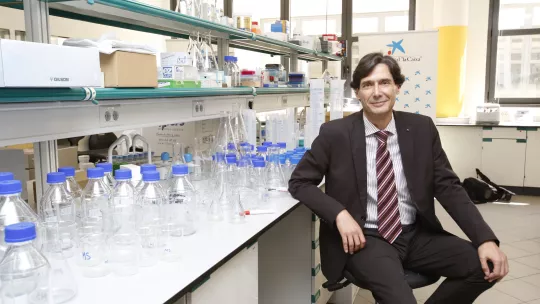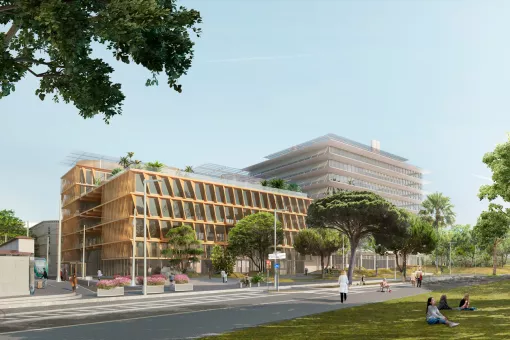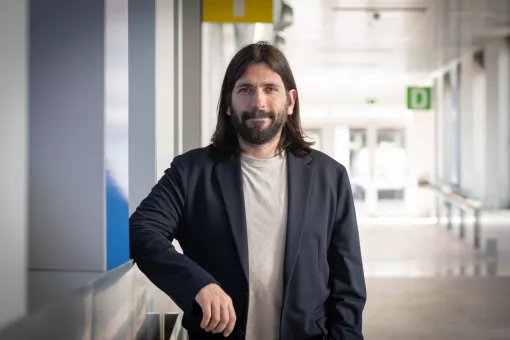Images
From cancer to tissue repair, from CNIO to IRB Barcelona
Something that characterises the scientist Manuel Serrano is his interest in working in areas that he has not addressed previously and that lie at the convergence between fields, cancer and aging, cancer and metabolism, or cancer and reprogramming. This boldness has been evident during his time at the helm of the “Tumour Suppressor Group” at the Centro Nacional de Investigaciones Oncológicas (CNIO) since 2003 and now accompanies him to IRB Barcelona, where his research group “Cellular Plasticity and Disease” will be able to “delve into more fields thanks to the multidisciplinary nature of the centre”.
— What will your research at IRB Barcelona be like?
— The main topic that I want to address is tissue repair. When tissue is damaged, the damaged cells—called senescent cells—play a key role, and we want to decipher how they tell the organism what needs repairing and how to do this. We also want to further our understanding of the dynamics of the cells responsible for tissue repair. Little is known about these fields but we have made some progress and can provide a different vision.
— What do you know so far?
— Tissue cells have a highly defined and delimited function. To repair a tissue, they first have to become versatile, that is to say, they have to acquire plasticity. Therefore the first thing they have to do is become non-specialised. In our lab we study how plasticity is acquired when tissue damage occurs. We are interested in this versatile state that allows these cells to repair damage.
The most widely studied and best known example of plasticity is the process of cell reprogramming, which was discovered by John B. Gurdon and Shinya Yamanaka.
—Are cell repair and reprogramming related?
— We work under the hypothesis that cell reprogramming is linked to the repair process that takes place in the cell.
— Which diseases or pathologies would benefit from these lines of research?
— There are many. We are working on diabetes and pulmonary fibrosis. In diabetes, the pancreas lacks cells that produce insulin, and the goal is to get this organ to generate these cells. In the case of pulmonary fibrosis, the lung tissue is very damaged and the damaged cells have not been removed and replaced by healthy ones. By means of drugs, we are attempting to remove the damaged cells and in this way stimulate repair.
— And what challenges do you face?
— How to induce this plasticity through drugs is still a challenge. We do this with genes but this can’t be done in a patient.
In this regard and in parallel with the setup of the lab at IRB Barcelona, at the beginning of the year I cofounded, together with three colleagues, my first spin-off, which is called Senolytic Therapeutics. Our aim is to take a drug that we have developed and patented to clinical trials. We have already demonstrated that this drug has the capacity to remove senescent cells that build up in damaged mouse tissue.
Time for change
— Why move away from cancer into tissue repair?
— My research focus has changed over time but cancer is still there. Chronic damage to tissue is one of the most widely known risk factors for the development of cancer. Defective repair underlies many diseases and I think that this notion is also applicable to cancer. This is why I felt that I have to take a step forward and study cell repair processes.
— Why did you choose IRB Barcelona?
— The institute has a highly varied scientific environment. There is a wide range of expertise in many diseases and fields, and this is very attractive. Whenever I have visited IRB, apart from being impressed by its level of science, I have appreciated an open and collaborative atmosphere, which is key to driving innovative ideas. Since I expressed my interest in joining the institute, the researchers here have responded most positively. I have an excellent personal relationship with them and without a doubt this is pivotal to ensure a creative working climate.
Also, changing centre and moving into a new city and setting is a way to reprogramme myself, to self-renew. It is a challenge.
— Regarding the new setting, do you think Catalonia is positioning itself as a hub to attract scientific talent?
— Yes, without a doubt. Because the Government of Catalonia is investing in talent attraction and retention, such as through the ICREA programme. When an investment is made it is necessary that those managing it apply professional and scientific criteria, a combination that ensures that the money is invested in an efficient manner and in such a way as to attract those working outside Catalonia. Catalonia has always adhered to criteria of scientific quality and excellence.
The backing of private foundations such as the Obra Social "la Caixa" is also crucial at a time in which funding from regional, national and European bodies has decreased. The commitment of these foundations to science is truly commendable.
— It is time to weigh up, how would you describe your time at CNIO?
— While at CNIO I matured as a scientist. It allowed my career to take a very important quantitative leap, because it provided me with resources and freedom: "Do what you want". I have been able to be creative, to explore and to delve into topics that I would otherwise not have got into.
Day to day life in the lab
— What is the working environment like in your lab?
— I make every effort to make people feel comfortable, to motivate them, to make them feel appreciated, and to ensure that they can talk freely.
— What do you demand of the young scientists starting in your lab?
— That they talk and ask questions. I always say to them: “Working in an unknown field is in fact pioneering science. I know as little as you and this is a good sign, it means that we are at the frontier of knowledge. We are going to work in this direction but I am not sure how things are going to go”. Sometimes they propose experiments that in my mind are impossible. I always tell them to go ahead and hope I have not made a mistake and that the experiment works.
— Is it the question you ask or your findings that allows you to achieving cutting-edge knowledge?
— Both. Asking ourselves what the relationship is between cell repair mechanisms and cell reprogramming is a big question. We could be asking ourselves a series of more basic questions based on the results we got yesterday, what happens if we change the dose, the time … You can focus on answering these types of questions, which is also very important and necessary.
— But, you are interested in other questions...
— Yes, I am interested in more “exploratory” questions.
(Written by: Llúcia Ribot)
About IRB Barcelona
The Institute for Research in Biomedicine (IRB Barcelona) pursues a society free of disease. To this end, it conducts multidisciplinary research of excellence to cure cancer and other diseases linked to ageing. It establishes technology transfer agreements with the pharmaceutical industry and major hospitals to bring research results closer to society, and organises a range of science outreach activities to engage the public in an open dialogue. IRB Barcelona is an international centre that hosts 400 researchers and more than 30 nationalities. Recognised as a Severo Ochoa Centre of Excellence since 2011, IRB Barcelona is a CERCA centre and member of the Barcelona Institute of Science and Technology (BIST).






